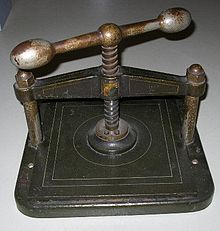Copy press
A copy press was used for copying of ink written paper documents in lower bearing . It was in 1780 by James Watt (1736-1819) for patent filed and is therefore also known as Watt's press referred.
Historical background
The General German Commercial Code committed since 1862 all merchants, a "copy or transcript" of sent them commercial letters kept (now § 238, paragraph 2 of the Commercial Code ). In order not to have to copy the originals, which is time-consuming and labor-intensive, mechanical copying machines were used. The copy press was used in many offices well into the 20th century. For longer runs, the copy press was increasingly being replaced by mimeographs and hectographs . Today, any number of copies can be made using a photocopier or completely paperless by copying digital copies .
functionality

The document to be copied, written on with special ink or a copier pen , was placed on a sheet of waxed paper and covered with unsized tissue paper , which was either moistened beforehand or again covered with a piece of damp cotton cloth. Finally, another sheet of wax paper was placed on top of it and the whole thing was subjected to high pressure between the two metal plates of a tightly tightened screw press (in which numerous layers of copied material could be pressed simultaneously) . The ink was dissolved by the moisture and penetrated through the tissue paper, so that the writing on the reverse side was visible. In the offices at the end of the 19th century, correspondence that had been written during the day was usually left in the press overnight, the letterhead was removed and the copies were finally collected in bound copy books. A simpler variant of the copier consisted of two pressure plates connected by hinges, which were spanned with brackets and pressed against each other by lever locks (Soennecken, around 1900). In addition, by 1900 there were also mechanical devices that delivered up to 1,000 copies per hour on long gauze strips that ran over heated drums.
About three prints can be made with good copier ink. Up to 20 prints can be made with highly concentrated ink and tissue paper soaked with special solutions. The tissue paper can be glued onto thicker paper after copying, so that the copy is more legible and more durable.
proof
- ↑ Link travel press 1877 ( Memento of the original dated November 9, 2014 in the Internet Archive ) Info: The archive link was inserted automatically and has not yet been checked. Please check the original and archive link according to the instructions and then remove this notice.
- ↑ Article Kopierpresse in Meyers Konversationslexikon, 1907